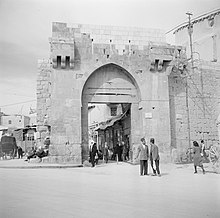Bāb Tūmā
Bāb Tūmā ( Arabic باب توما 'Gate of Thomas') is one of the seven city gates of Damascus , which is located in the northeast of the old city . At the same time, it is the name for a centuries-old district in the north-eastern part of the old town located south of the city gate . Today the district is almost exclusively inhabited by Christians and has several thousand inhabitants.
history
Today's Bāb Tūmā was one of seven city gates of Damascus that already existed in Roman times . Like the days of the week, all gates were dedicated to one of the seven deities, who also corresponded to the five planets known at the time, the sun and the moon. Like the other city gates, the northeast gate also had three arches with passageways - in the middle for vehicles, on the two edges for pedestrians. Bāb Tūmā was then the gate of Venus . After the establishment of Christianity in Damascus, which was still Roman, the gate after Thomas the Apostle was given the name "Thomastor", which it retained after the Arab-Islamic conquest - now in its Arabic form Bāb Tūmā . During the Ayyubid period , the gate was renewed in the 13th century and was essentially given its current shape with only one passage.
On old photos you can still see that the city wall and the residential buildings directly adjacent to it on both sides of the Bāb Tūmā were intact until the 20th century. The gateway to a bottleneck for increasing car traffic. In the 1950s, the city wall around the gate as well as the houses next to it were demolished for a roundabout that still exists today.
Culture

The Christian religion is lived freely and openly by the residents of the Christian quarter of Damascus , as evidenced by a large number of churches and small altars in street niches. Public life is relatively autonomous from that in the rest of Damascus. Almost all shops are open on Friday ( Islamic holiday), but many shopkeepers close on Sundays.
Bāb Tūmā is also known as the student quarters. A large number of Western or Asian foreigners studying in Damascus are housed with families in Bāb Tūmā.
Streets and attractions nearby
From the eastern section of Straight Street , Bab-Sharqi-Street, Bāb-Tūmā Street leads north, in sections northeast to Bāb Tūmā, on which there are several churches of different denominations. One of them is the Cathedral of St. George in the southern section on the east side of the street , which is the seat of the Syrian Orthodox Patriarch Ignatius Ephrem II Karim . The latter, however, mostly resides in the predominantly Christian small town of Saidnaya . On the east side of this street there are also two large Roman Catholic monasteries, the Lazarist monastery Damascus and - already close to the city gate - the Franciscan monastery Damascus on the corner of Klosterstraße. To the northeast opposite the monastery is the Maronite Cathedral of Damascus on Klosterstrasse . Only 100 m west of the city gate is the Armenian Catholic Church of the Queen of the Universe and almost opposite to the south the 500 year old Hammam Bakri . There are also three mosques to the north and northwest of the city gate and to the south (in the Christian quarter) another one next to the Maronite cathedral.
Web links
- Dorothée Sack : Damascus, Syria. Bait Sarji and Bait Yazi. The "big" and the "small" house at Bab Sharqi - a mirror of the events !? ( Memento from June 6, 2016 in the Internet Archive ). In: Jahrbuch MSD 2006-08, Berlin 2008, p. 82 ( download the entire issue as a PDF file ).
Individual evidence
- ↑ Bab Touma. Love Damascus. Your guide to the oldest living city, accessed May 14, 2020.
- ↑ Example image with Bāb Tūmā, tram tracks still recognizable, accessed on May 14, 2020.
Coordinates: 33 ° 30 ′ 49.2 " N , 36 ° 18 ′ 54.7" E
